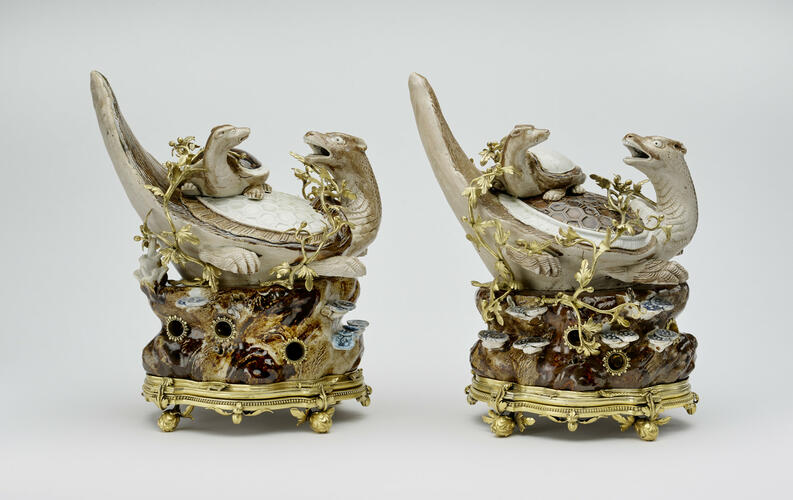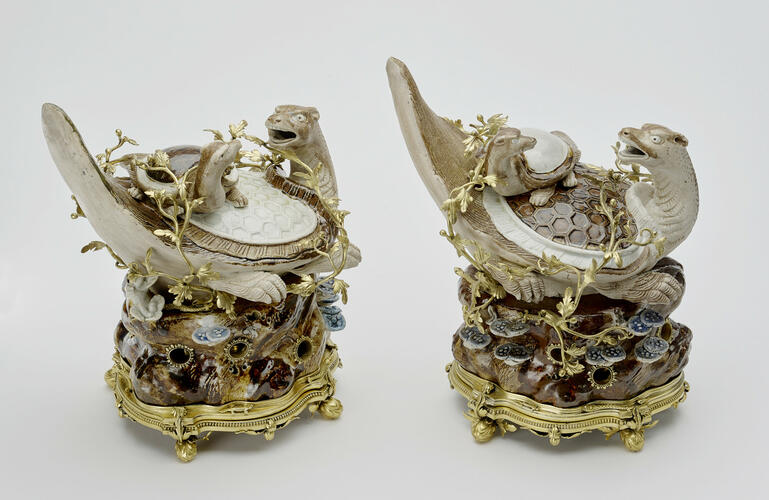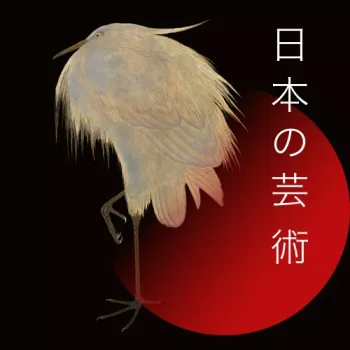Pair of pastille burners in the form of tortoises burners: 1680-1700, mounts: 1700-50
Porcelain decorated with brown and blue glazes, mounted in gilt bronze | 25.0 x 21.7 x 15.0 cm (whole object) | RCIN 4961

Japan
Master: Pair of pastille burners in the form of tortoises burners: 1680-1700, mounts: 1700-50

Japan
Master: Pair of pastille burners in the form of tortoises burners: 1680-1700, mounts: 1700-50



-
The tortoise (kame) is a symbol of longevity in China and Japan. One mythical tortoise known as minogame is said to have lived for 10,000 years – so long, in fact, that a trail of algae began to grow on its back. In Europe, this trailing weed was often misinterpreted as fire, giving rise to the name ‘flaming tortoise’ for these creatures. Strands of algae are absent here and the tortoises’ upturned necks and open mouths instead suggest a playful interaction with the young on their backs.
Models of this kind were imported by the VOC as early as 1665, when the ship Nieuwenhoven brought to Holland some 295 ‘statuettes on tortoises’ and 346 tortoises. This pair are nevertheless rare examples of this form. Enlivened by dots and lines incised on their bodies, the creatures serve as pastille burners. The tortoises were originally designed to emit incense through their open mouths, but the addition of the hollow stump has blocked up the cavities. Instead, fragrance now diffuses via the gilt-lined holes which were added to the stumps in France.
This pair was recorded at the Royal Pavilion, Brighton, in 1829, and later displayed by Queen Mary in her Tea Room at Buckingham Palace in 1917.
The figure of a minogame tortoise is posed on a tree stump, its large pointed tail forming a handle, the long neck and head turned back to look at its young perched on its back, the open mouth originally intended to emit the fragrance, the four feet projecting before and behind. Its body is enlivened with incised dots on the neck and strokes on the tail, both dressed with brown glaze, and the carapace moulded with a hexagon pattern, brown-glazed with a white border on RCIN 4961.1 and with the order reversed on RCIN 4961.2, the young in each case coloured in contrast. The separately fired hollow stump is gnarled and covered in brown glaze, in parts applied only thinly on the biscuit; and growing on it, blue mushrooms. Gilt-bronze wire floral sprays with leaves and berries reach around and over each turtle, the wires attached to the stump by four screws, and six holes piercing the sides of the stump are framed in gilt bronze. A shaped oval gilt-bronze base is attached to the foot of the stump, encrusted with shells, fish, lizards and snakes. The lower part (with beaded edge) is entirely separate and is raised on four tulip-and-leaf feet. Attached to the top surface of the base is a lobed gilt-bronze burner with gadrooned lip, which sits within the porcelain stump and serves as a censer.
Text adapted from Chinese and Japanese Works of Art in the Collection of Her Majesty The Queen: Volume II and Japan: Courts and Culture (2020)Provenance
Almost certainly acquired by George IV. Listed in the Brighton Pavilion Inventory as ‘A pair of Tortoise Potpourris on Rock bases, mounted in ormolu, ten inches [25.4 cm]’ (1829B, p. 109); sent to Buckingham Palace in March 1847 (1829A, p. 14), where they were noted, in 1917, in Her Majesty’s Tea Room (1829B, p. 109).
Recorded in the Lacquer Room at Buckingham Palace in 1911 (BP 1911 IV p.199). -
Creator(s)
(nationality)(metalworker)Acquirer(s)
-
Medium and techniques
Porcelain decorated with brown and blue glazes, mounted in gilt bronze
Measurements
25.0 x 21.7 x 15.0 cm (whole object)
Category
Object type(s)
Other number(s)








